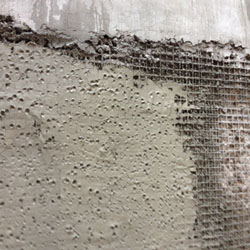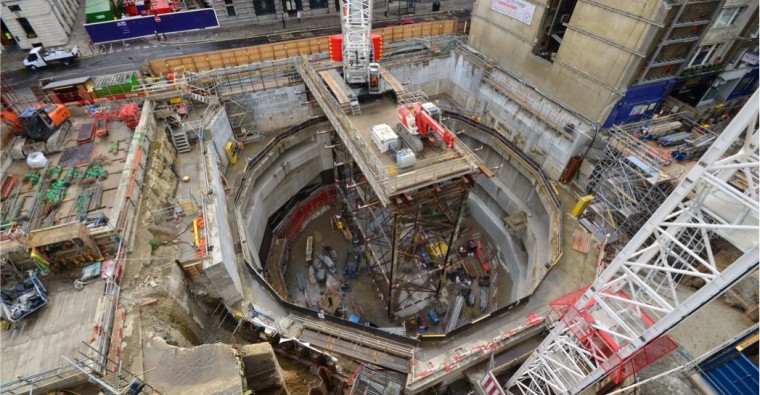Assuring the Design Life of Crossrail’s Moorgate Shaft by Chris Lloyd, Director of Flexcrete Technologies Limited
Currently Europe’s largest infrastructure project, the £14.8 billion Crossrail development has recently reached a major milestone with the completion of 26 miles of tunnelling under London.
Crossrail will provide a high frequency rail service that will link parts of Berkshire and Buckinghamshire, via central London, to Essex and South East London, providing additional transport capacity and reducing congestion on London Underground. Services through central London will commence in 2018, around 200 million passengers will travel on Crossrail each year and the route will provide a 10% increase to London’s rail capacity.
Construction is also advancing on the 10 new Crossrail stations and on works above ground west of Paddington and east of Stratford, with over 10,000 people working on the project. One of the new Crossrail stations being built is Liverpool Street Station which will have two new ticket halls located at Liverpool Street and Moorgate, with both ticket halls providing access to the Crossrail station.
One of the Largest Concrete Pours on Crossrail
At the western end of Liverpool Street Station, a new ticket hall is under construction and the development in which it is housed contains a 42 metre deep shaft with piles 60 metres deep and steel reinforced rings to secure the permanent structure. Known as Moorgate Shaft, it was newly constructed to provide access and ventilation to the new ticket hall. The final concrete pour of 1,800m³ was one of the largest on Crossrail and took 32 hours to complete.
Concrete Repair Material Specification
In order to underpin and assure the design life of the structure, and provide a solution to non-conformance with specification, Bam Nuttall Kier Joint Venture was seeking a London Underground approved concrete repair material that could provide a 120-year design life in accordance with the overall requirements and strength of the parent concrete.
to underpin and assure the design life of the structure, and provide a solution to non-conformance with specification, Bam Nuttall Kier Joint Venture was seeking a London Underground approved concrete repair material that could provide a 120-year design life in accordance with the overall requirements and strength of the parent concrete.
An area of 50m² needed to be reinstated on the new concrete shaft walls at a thickness of 10-80mm, and the specification called for the use of stainless steel mesh to provide a good bond. Due to the limited access, speed of application and variations in thickness, a wet sprayed mortar – Monomix WS – was chosen to enhance the durability of Moorgate Shaft. Monomix WS was selected for the re-alignment of the top section of Moorgate Shaft after the concrete pour proved to be out of tolerance vertically. Once the mesh reinforcement was in place, the application contractor Prestec UK Ltd was able to achieve the thickness variations by spraying techniques.
Other Concrete Repair Options
Other possible options included hand applied, pourable and dry sprayed repair materials. Hand applied mortars were not a viable option, as the application would have proved to be laborious over such a large area and it would have been difficult to work around the stainless steel mesh that was specified.
Similarly, pourable repair materials were not practical for this project as the 10-80mm depth of section, coupled with the mesh reinforcement, would have made it impossible to guarantee that a pourable grout would not leave voids. The sheer size of the repair would also have made it challenging to achieve a continuous pour which is a standard requirement on such repairs in order to prevent cold joints.
Dry sprayed repair materials would have been an option, however the amount of dust and rebound that this technique generates precludes its use in confined environments. The wet sprayed mortar presented by far the most sensible and practical option as Prestec UK Ltd was able to quickly and efficiently apply the material in a single application with minimal rebound or dust generation.
Selection of Wet Sprayed Method
Access was limited and with the wet spray method the application contractor was able to use a mixer pump situated on a gantry above the actual work. This meant the Monomix WS could be mixed away from the application area and fed continuously down to the spray team. To facilitate this, a falsework temporary floor was erected.
Monomix WS is a Class R3 spray applied repair mortar which is supplied as a single component product, only requiring the addition of clean water on-site and no substrate or  inter-layer priming. Rapidly applied by wet process techniques with a maximum application thickness in excess of 80mm in vertical, horizontal and overhead situations, its high bond strength exceeds the tensile strength of concrete, ensuring a monolithic performance of the repair. It has excellent low sag properties and its dense matrix offers low permeability to water, even at 10 bar positive and negative pressure, and very high diffusion resistance to acid gases and chloride ions. Non-toxic when cured, it is CE marked in compliance with BS EN 1504 Part 3 and is certified by the British Board of Agrément (BBA).
inter-layer priming. Rapidly applied by wet process techniques with a maximum application thickness in excess of 80mm in vertical, horizontal and overhead situations, its high bond strength exceeds the tensile strength of concrete, ensuring a monolithic performance of the repair. It has excellent low sag properties and its dense matrix offers low permeability to water, even at 10 bar positive and negative pressure, and very high diffusion resistance to acid gases and chloride ions. Non-toxic when cured, it is CE marked in compliance with BS EN 1504 Part 3 and is certified by the British Board of Agrément (BBA).
In order to prevent rapid drying out of the mortar, Curing Membrane WB was applied to the surface immediately after finishing. With a waterborne formulation and backed by British Board of Agrément (BBA) approval, it can be safely applied in enclosed locations as it releases no hazardous solvents or strong odour. This repair system provided an ideal solution for this high profile Crossrail project, ensuring full conformance with specification, and an assurance that it would achieve the 120 year design life. The client was delighted with the finished work.




